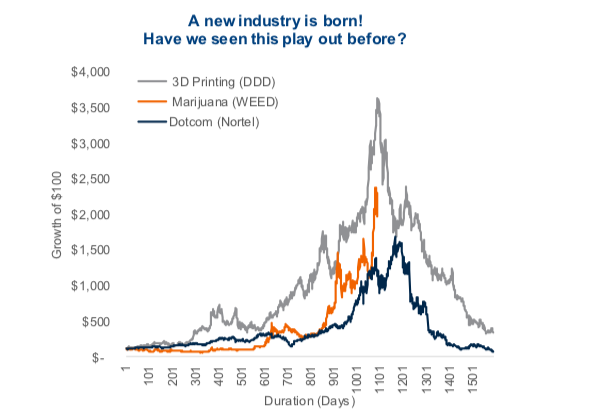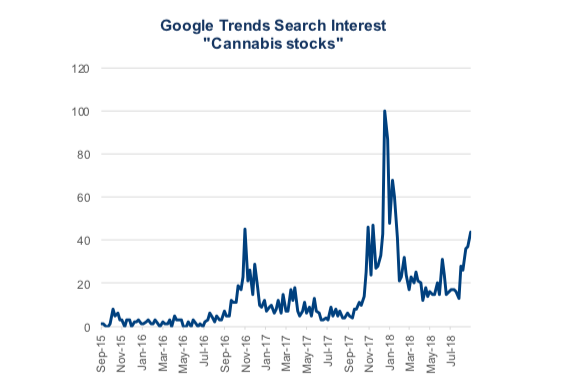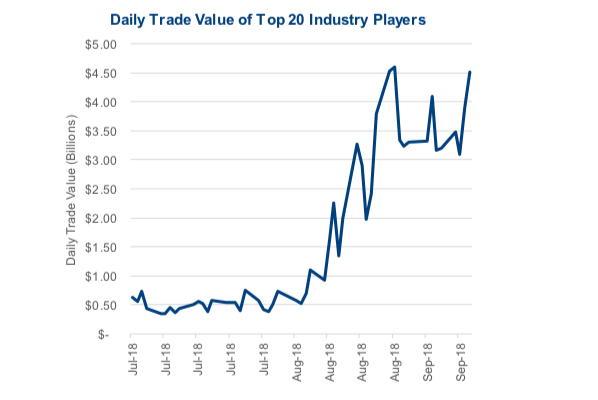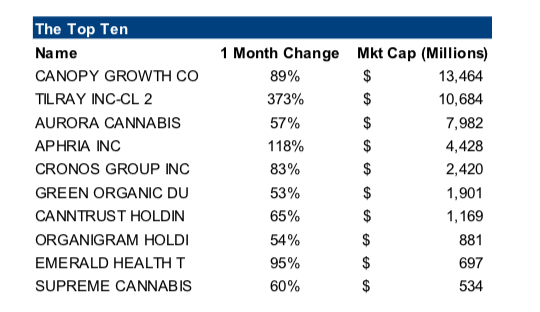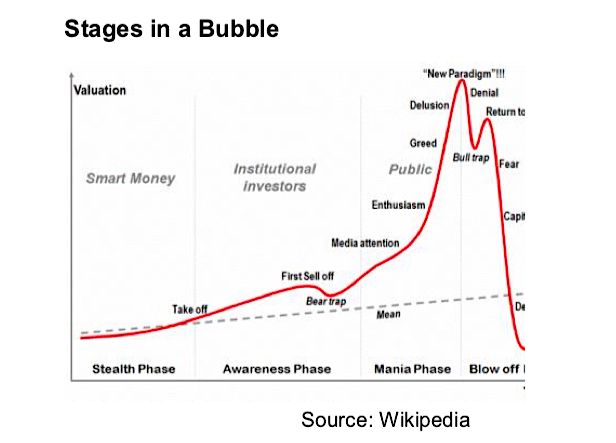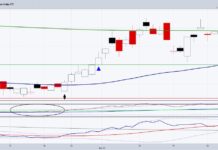We believe three factors drive stock prices: fundamentals, technical analysis and human behavior (market psychology).
Fundamentals tend to play out and are the driving force of long-term results, technical analysis can help you manage the turn, but flow in human behavior can dominate all else and drive stock prices far beyond rational explanation… and create market bubbles.
Just think back to the start of this year when Bitcoin was coming off a rise of 1,403% in 2017. It is now down 65% from those highs. Did the fundamentals change or did market psychology hit a tipping point?
During the euphoria for crypto investors, we penned an article titled The Anatomy of a Bubble. In it we highlighted the common ingredients to a market bubble including the ease of money, access to leverage, new technologies, changes in regulation and broad public speculation.
At the time, Bitcoin had many of many of these ingredients, and we now see numerous similarities happening in the Canadian cannabis industry. Regulation is changing, access to capital is bountiful, and there is broad market speculation.
With recreational legalization exactly one month away (October 17, 2018), Canada will become the first G7 country to legalize cannabis consumption fully. It is the end of prohibition and the birth of an industry. We will likely see only a handful of opportunities like this in our lifetime.
As we see in chart 1, we are well beyond the smart money and institutional investor phase and smack in the middle of the retail “public” investor mania. In a due diligence meeting with Cam Battley, Chief Corporate Officer of Aurora Cannabis, he estimated that 85% of their shares are owned by retail, something he would like to see change over time.
It is easy to show this rise in interest (chart 2) with Google search trend scores spiking (chart 3) and trading volume proliferating.
All the charts tell one story, a cycle that has been seen countless times over in history. One of greed based on what the future may hold.
This irrational exuberance, a term coined by Nobel Laureate Robert Shiller, is predicated on a positive feedback loop, and explains how the prices reach over-extended levels. Feedback loops and other behavioral mistakes are critical components in every market bubble in history.
Wisdom of crowds
James Surowiecki’s 2005 book on the wisdom of crowds explains that large groups of people, on average, are incredibly accurate in making predictions. This thesis was not new with Francis Falton, back in 1907, showing the average of the guesses of an Ox’s weight was more accurate than most individual guesses and even those of cattle experts. However, for the thesis to work, everyone needs to be thinking independently. If people allow themselves to be influenced by what they read on Google, through a conversation with an uber driver, or from watching others get rich in a trendy stock, that wisdom can turn to buffoonery.
It’s human nature
Speculators flock where there is the potential to get rich, not where valuations make sense. Warren Buffet put it rather succinctly when he said: “People start being interested in something because it’s going up, not because they understand it or anything else”. They want in because they see neighbors who are dumber than they are getting rich, and want to get in on the action. It’s the fear of missing out that drives us towards the action, however much like mosquitoes getting zapped flying to close to the light, flying too close can be a fatal mistake for investors.
Cannabis industry outlook
We have been closely following the cannabis industry from the time GMP Capital was bringing around Bruce Linton, Canopy CEO on the IPO tour back in 2014. Much has changed, and there are more changes to come. Statistics Canada estimates that Canadians spent $5.6bb on the product last year. That is punitive to the global alcohol industry but when we met with Cam Battley last week, he projected that the global cannabis industry will be bigger than the alcohol industry in just a few years. That might be an aggressive estimation, but if other developed nations continue to legalize medical use and watch Canada as a litmus test, examining job growth, tax revenue and the downfalls, there could be other nations that follow suit, vastly opening up the addressable market, but that is still a big if.
Unlike alcohol, which has a single use (getting you drunk), cannabinoids have other uses and over 100 distinct physiocratic influences according to Brad Rogers, President of CannTrust. In our meeting with Mr. Rogers earlier this month, he identified many other end markets for marijuana including, medical use for pets, nanotechnology enabling flavorless absorption for libation drinks, hemp as a non-animal source of protein, recovery sports beverages and the list goes on. There will certainly be an investment opportunity in the industry, but if you are experiencing FOMO (fear of missing out), there is still time, and we think a better entry point will present itself, broadly speaking.
Just the facts
Share prices for cannabis companies are not based on fundamentals. From our meetings this month with two of the largest players in the space (TRST, ACB) it is clear, they are working hard trying to capitalize on the hype. Both are working avidly to get U.S. listings, so the target market of investors is expanded, adding to the aforementioned feedback loop.
Valuations for cannabis companies are a little bit off the charts using any typical metrics. (but of course, it’s different this time). The space has soared once again this past month, no doubt there is a long runway for growth. Every other week there is a new study predicting potential consumer spending and medical applications. We don’t doubt that the market will grow, but even accounting for lofty growth expectations and the total elimination of the black market (unlikely), that might not be enough to justify current valuations.
Dilution is also a major issue, when market share is imperative, issuing new paper at high valuations can make sense, but it is dilutive. Not to mention the warrants and options that will be exercised at current valuations.
Can bubbles be prevented?
Likely not, it’s human nature, and part of the history of capitalistic society.
We wouldn’t have a continental rail system without the rail mania of the late 1800s. It ended with about a third of all railroads going bankrupt, but the rails stayed in the ground, freight prices fell drastically, and the rails became the new backbone of a nation.
The same happened with the dotcom bust. The infrastructure built during the bubble wasn’t dismantled. Instead, the internet became ingrained in business as well as our personal lives.
While cannabis legalization isn’t as revolutionary as millions of miles of track, or even fiber optic cable, it does have some similarities to the birth of other industries. The same can be said with blockchain technology, the infrastructure behind Bitcoin.
Investors always overestimate the impact of the “next big thing”. Remember 3d printing, the technology that was going to revolutionize manufacturing as we know it? Well it’s still around, and increasingly being used, but big companies in the space that got swept up in the mania are likely never going to reach their previously lofty heights. Chart 5 shows the similarities across a similar timeframe between 3D Printing (DDD) and Canopy Growth (WEED)… Some bubbles grow larger than others, but the results are always the same – pop! Good companies are not immune; even Microsoft took 16 years to reach the levels seen in the dotcom mania.
What next
The chart 6 is a general roadmap to a bubble developed by Dr. Jena-Paul Rodrigue from Hofstra University. It provides a very neat and tidy roadmap for the development of bubbles.
We’ve lost count of the number of Uber drivers and the number of casual conversations at parties over the past year wanting to talk weed stocks. We’re well past media attention and likely somewhere between “Greed” and “Delusion”, well on the way to “New Paradigm”. We do not know how long this will last, but eventually, the smoke will dissipate, and reddish eyes will look back and wonder how they failed to see the signs.
Data charts are sourced to Bloomberg unless noted otherwise.
Twitter: @sobata416 @ConnectedWealth
Any opinions expressed herein are solely those of the authors, and do not in any way represent the views or opinions of any other person or entity.

